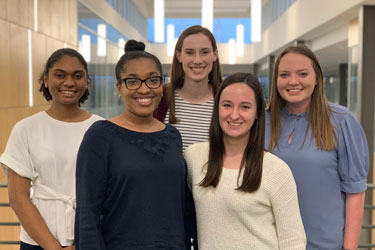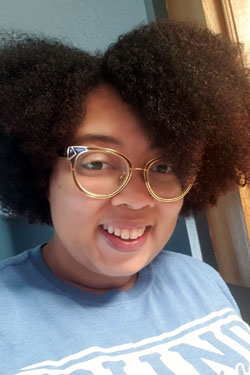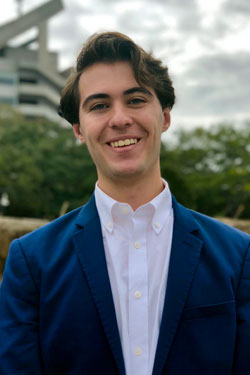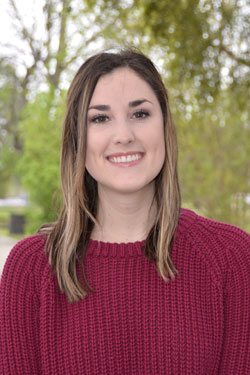Undergraduate Research Opportunities Program
About UROP | FAQs | Funded Projects | Application | Contact
Funded Projects: 2019
 Amber Jarrell, Dominique Angibeau, Megan Devine, Alison Carrier, and Claire Stansbury, Louisiana State University
Amber Jarrell, Dominique Angibeau, Megan Devine, Alison Carrier, and Claire Stansbury, Louisiana State University
Advisor: Subramaniam Sathivel, LSU AgCenter
Evaluating a Chill Spray System Utilizing a Chitosan Solution for the Inactivation of Pathogens on the Surface of Fresh Shrimp
Chitosan is a sugar polymer created from crustacean shells and has been shown to have antimicrobial properties. The undergraduate team of Jarrell, Angibeau, Devine, Carrier, and Stansbury will determine the effectiveness of a chill system that sprays chitosan to reduce Listeria levels from shrimp, all while maintaining the quality of the product.
 Briante Brumfield, Southern University at New Orleans
Briante Brumfield, Southern University at New Orleans
Advisor: Abigail Bockus, Louisiana Universities Marine Consortium (LUMCON)
Characterizing the Effects of Temperature on Hypoxia Tolerance in Gulf Brown Shrimp to Support Directed Fishing Efforts Offshore
Shrimp support the most valuable commercial fishery in Louisiana. Each year, parts of the coast are threatened with periods of low oxygen (hypoxia) and it’s important to know how these species will respond. Brumfield will study how changes in temperature affect brown shrimp’s ability to tolerate hypoxia, providing valuable information for the shrimp industry.
 Noel Dudeck, Louisiana State University
Noel Dudeck, Louisiana State University
Advisor: Giulio Mariotti, Louisiana State University
Waves, Mixing and Resuspension in University Lake: Restoration Implications
Previous efforts at restoring the lakes adjacent to LSU have not met with long-term success, especially concerning water quality. Dudeck hopes to address this by determining how winddriven waves in University Lake drive sediment resuspension and deposition, mix water and affect water aeration. This information can better inform potential dredging in hopes of lasting, cost-efficient restoration.
 Megan Guidry, Louisiana State University
Megan Guidry, Louisiana State University
Advisor: Morgan Kelly, Louisiana State University
Variation in the Microbiome of the Eastern Oyster: Environmental Influences and Effects on Oyster Health
Little research has been conducted on oyster microbiomes. Guidry will correct this by studying different oyster reef microbiomes over time and looking at the interactions between the microbiome communities, salinity and dermo infection state. These Louisiana-specific results will provide a predictive tool for monitoring populations at risk of dermo infection.
 Matthew Hutchins, Louisiana State University
Matthew Hutchins, Louisiana State University
Advisor: Maria Teresa Gutierrez-Wing, Louisiana State University
Hydrogel-based System for Microalgal Cultures Dewatering
Photosynthetic microalgae have many advantages for product development. While initial efforts focused on biofuels, these microorganisms are sources of valuable products like pharmaceuticals and food. Dewatering the microalgal biomass is an expensive part of the process. Hutchins will determine how physical and chemical variables affect dewatering performance of highly absorbent polymers, called hydrogels, in cultures made from microalgae.
 Erik Johnson, Tulane University
Erik Johnson, Tulane University
Advisor: Caroline Taylor, Tulane
Avian Coastal Ecology: Survival and Movement in Beach-nesting Birds using Radio Telemetry
Louisiana’s coast is threatened by sea-level rise, putting beach-nesting birds on the front lines. One such species of concern is the Wilson’s plover, to which Louisiana is home for 30 percent of the U.S. population. Johnson will investigate how movements and habitat quality affect the survival of newly-hatched chicks of this understudied species.
 Katerine Kjos, Louisiana State University
Katerine Kjos, Louisiana State University
Advisor: Michael Polito, Louisiana State University
Identifying the Geographical Origin of Domestic and Imported Crawfish Using Stable Isotope Analysis
Louisiana leads the nation is crawfish aquaculture, but farmers face competition from imports. Regulations require producers to identify the country of origin, but currently there is no way to independently verify and enforce these labeling laws. Kjos will use stable isotope analysis on packaged crawfish tail meat to provide much needed validation of geographic origin and harvest status product labeling.
 Claire Lanclos, Louisiana State University
Claire Lanclos, Louisiana State University
Advisor: Subramaniam Sathivel, LSU Agricultural Center
Reducing Pathogen Loads on Shrimp with Water Soluble Bacteriocins of Lactic Acid Probiotic Bacteria
Concerns exist about pathogenic microorganisms in seafood, creating high demand for safe products with little to no additives. Water soluble bacteriocins from probiotics may reduce pathogenic loads. Lanclos will evaluate the effectiveness of environmentally friendly bacteriocins in reducing Listeria loads when they are added to shrimp.
 Grace Nguyen, Louisiana State University
Grace Nguyen, Louisiana State University
Advisor: Todd Monroe, Louisiana State University
Development of a Standardized Artificial Inseminator for Freshwater Live-bearing Fishes
Small, freshwater fish are important for aquaculture, the aquarium trade and environmental biomonitoring. Rearing the live-bearing fish, however, is challenging as current methods haven’t been updated since the 1950s. Nguyen will work to modernize the protocol by developing a standardized inseminator to assist in the artificial insemination of these species.
 Juan Touza, Louisiana State University
Juan Touza, Louisiana State University
Advisor: Evelyn Watts, LSU AgCenter
Effect of Lactic Acid on Shelf Life of Fresh Crawfish Tail Meat
The shelf life of fresh seafood is limited. To reach larger, more distant markets, processors need to extend this shelf life. Applying lactic acid during chilling can result in seafood staying fresher longer. Touza will determine the effect of 0 to 2 percent lactic acid on the shelf life of fresh crawfish tail meat, allowing the industry to expand beyond regional markets.
Amina Meselhe, Louisiana State University
Advisor: Navid Jafari, Louisiana State University
Biomechanical Properties of Wetland Vegetation for Quantifying Wave Attenuation
Wetland plants provide important benefits to Louisiana’s coast, but it’s unclear how well they protect against storms. Even less clear is how vegetation stems respond to the stress from storm activity. The student will study the vegetative properties of Spartina alterniflora’s and determine its biomechanical and physical properties. This will clarify vegetation bending and breakage which ultimately affects wave attenuation.
